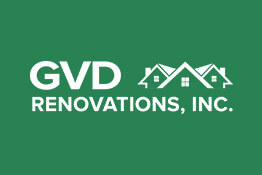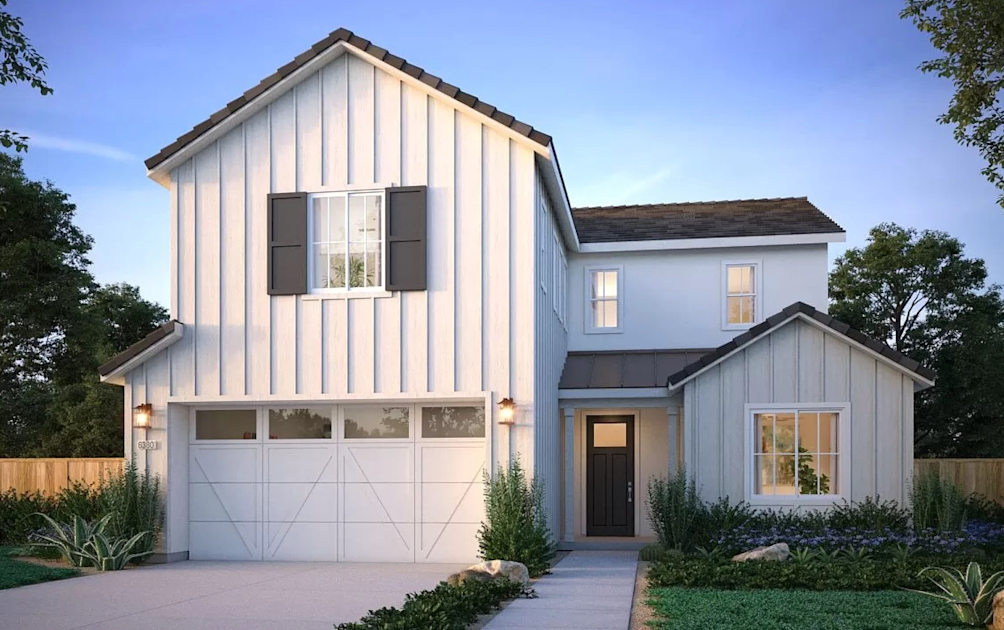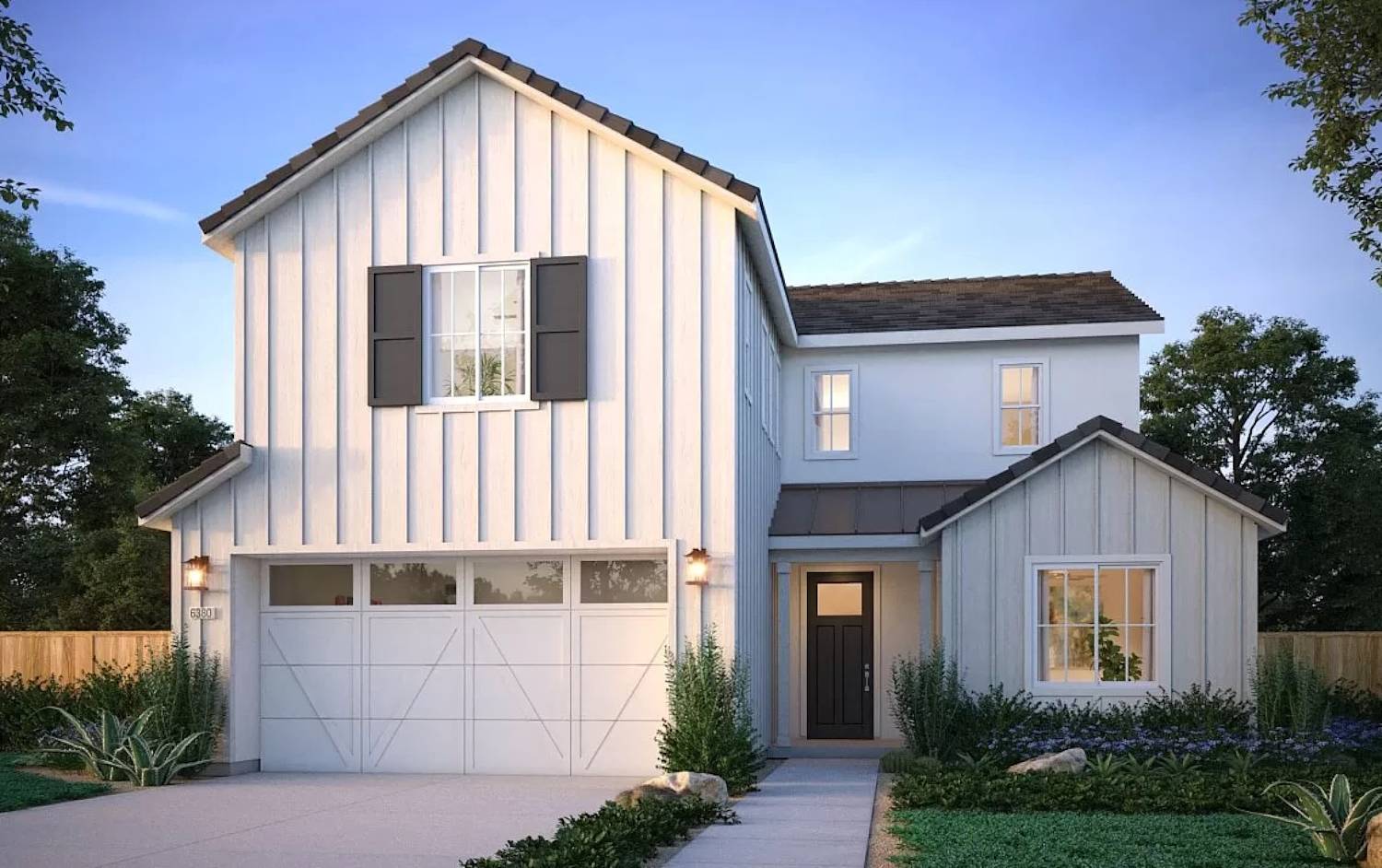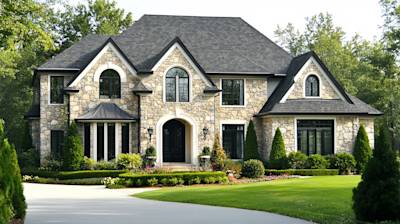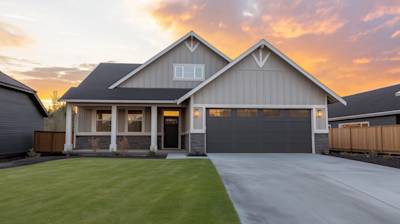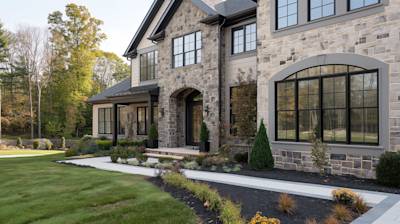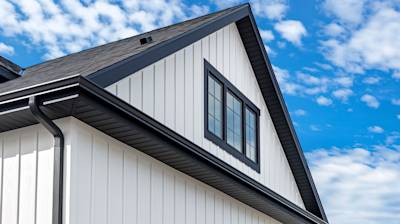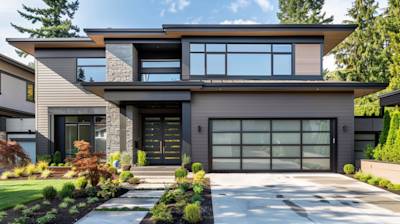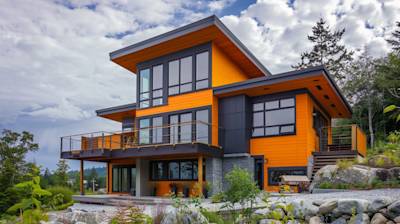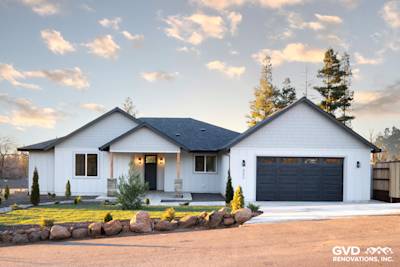Board and Batten Siding
Board and batten siding, which comes from 19th-century barns and houses, has become popular again in today's architecture. Vertical sidng's rustic-yet-modern aesthetics and high durability are a match made in heaven for most homeowners.
Understanding Board and Batten Siding
vertical batten siding is an exterior treatment of vertical boards with battens covering the seams. The ‘board’ refers to the wide, flat piece of wood, while the ‘batten’ is the smaller strip that overlays where two boards meet. This thoughtful design effectively blocks any gaps, preventing weather damage and infiltration by pests.
Materials Used for Board and Batten Siding
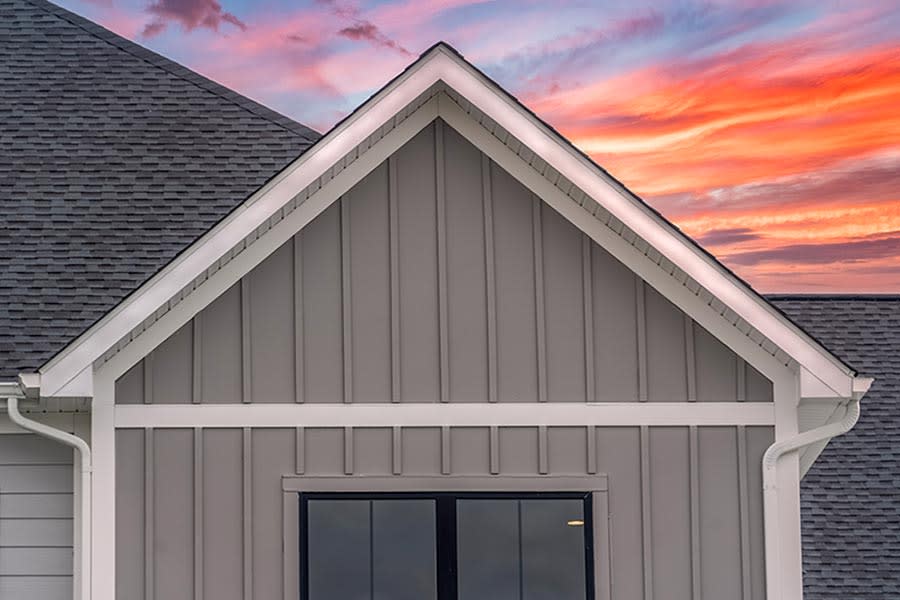
You can use several materials for board and batten siding, with the most common options being:
- Wood: For its natural and aesthetic appeal
- Vinyl: For its wide range of choices and low maintenance requirements
- Engineered Wood: For its durability and wider width ranges
- Fiber Cement: For its fire resistance and graphic design possibilities
Installing Board and Batten Siding
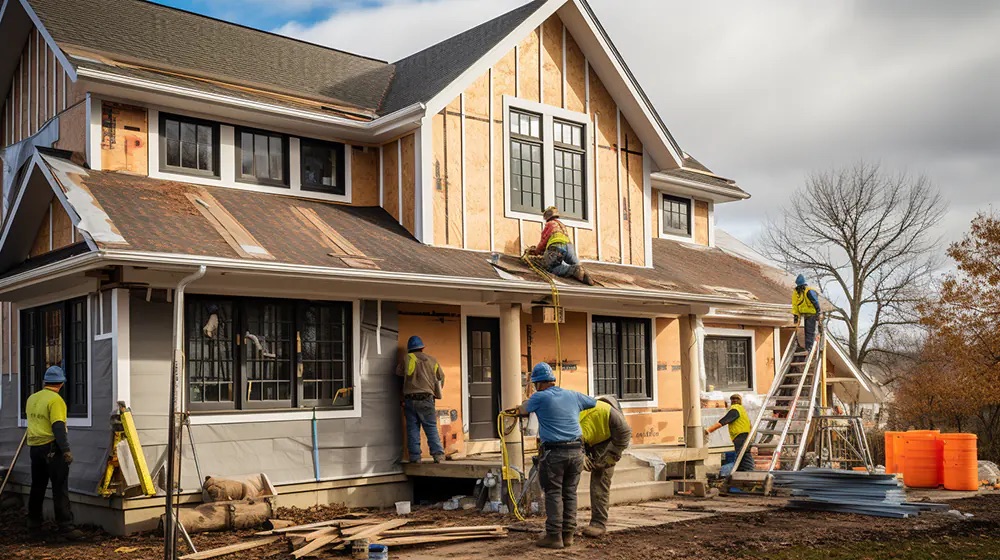
Measurement and Preparation
The first step towards installing vertical siding is preparing and measuring your wall. Careful measurements allow you to determine the amount of siding needed. Always remember to account for an extra 10% material for errors or future repairs.
Laying the First Board
The first board should be laid from bottom to top and nailed with galvanized nails at the top, middle, and bottom. It serves as the base for any subsequent boards.
Adding Battens
Once the boards are laid, it’s time to add the battens. Starting from one end, place the batten over each seam where two boards meet. Ensure they're placed correctly to prevent moisture seepage.
Maintaining Your Board and Batten Siding

vertical batten siding, like all siding options, needs regular maintenance to ensure its longevity.
Regular Cleaning
A power washer can help remove dirt, grime, and mildew that collects over time, especially before a new coat of paint.
Timely Repairs
Examine your siding regularly for signs of damage. Early detection can prevent extensive and costly repairs in the future.
Paint and Stain
Regularly apply a new coat of paint or stain can ensure your board and batten siding maintains its fresh appearance and remain protected against the elements.
Designing with Board and Batten Siding
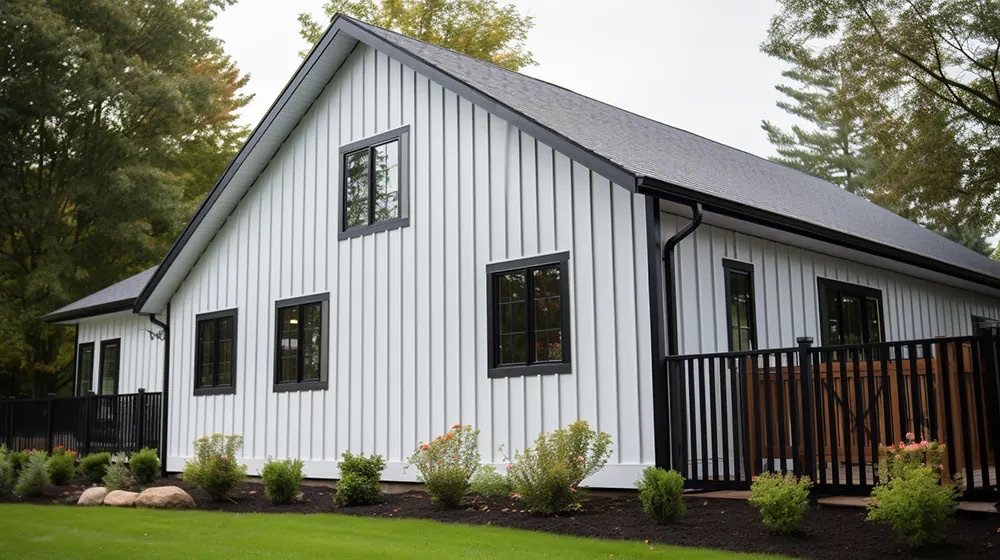
Board and batten siding comes with limitless design possibilities, providing flexibility to your architectural layout. Whether you prefer vertical, horizontal or diagonal boards, or a combination of two; board and batten siding effortlessly enhance the overall aesthetics.
Costs of Board and Batten Siding

The cost of board and batten siding depends on the material you've chosen and the size of the required siding. It's crucial to consider both the initial installation cost and the long-term maintenance costs for an informed decision.
This comprehensive guide should arm you with foundational knowledge about board and batten siding, helping you make an informed decision for your home. Whether you’re after the traditional countryside look or striving for a modern seamless design, board and batten siding is a robust and dynamic choice.
Frequently Asked Questions about Board and Batten Siding
How does board and batten siding installation work?
The installation of board and batten siding typically involves placing wider 'board' pieces of siding over a home's exterior wall and then covering the seams with narrower 'batten' pieces. It's a layered approach that can be done vertically or horizontally, depending on design preferences. Professionals typically handle this task to ensure the process is done efficiently and accurately, ensuring the longevity of the siding.
Does board and batten siding require regular maintenance?
While board and batten siding is known for its durability and robustness, minimal maintenance is still necessary to ensure its longevity. This may involve regular cleaning, periodically checking for signs of damage, and repainting or re-staining, depending on whether your siding is wood or a different material.
How long can board and batten siding last?
With proper installation and routine maintenance, board and batten siding can last several decades. Many homeowners enjoy the longevity of this exterior house siding, which can endure anywhere from 20 to 40 years, sometimes even longer.
Is board and batten siding suitable for any architectural style?
Board and batten siding is versatile and works with a variety of architectural styles. It's a common choice for rural or rustic style homes like cottages, farmhouses, and barn conversions. However, its simple and classic appeal can complement more modern designs, too.
How is board and batten siding different from other siding types?
Unlike horizontal siding types like clapboard, board and batten siding is typically installed vertically. This unique orientation creates a unique visual profile that can make a structure appear taller. It's also different in that the boards and battens create a layered, three-dimensional effect.
What kind of materials can be used in board and batten siding?
The most traditional material for board and batten siding is wood, often cedar due to its natural resistance to rot and insects. However, in recent years, other materials like vinyl, aluminum, and engineered wood have grown in popularity due to their durability and relatively low maintenance needs.
Can board and batten siding offer insulation to a home?
While the primary goal of board and batten siding is to protect the home's structure, it does provide some insulation properties. However, for optimal energy efficiency, quality wall insulation underneath the siding is key.
How much does installing board and batten siding cost?
The cost of installing board and batten siding can depend on several variables like material, home size, labor costs, and the complexity of the installation. Many homeowners find it to be a cost-effective siding choice, especially considering its lifespan and low maintenance needs.
Can I install board and batten siding by myself?
While it's possible to install board and batten siding as a DIY project, it's usually recommended that you hire a professional. Professionals have the expertise to handle any challenges that may arise during installation and can ensure that the siding is safely and accurately installed.
Can I paint my board and batten siding in different colors?
Yes, board and batten siding can certainly be painted or stained in different colors to match your personal style or exterior design. It's a fantastic way to add a pop of color or accentuate the unique features of your home.
How to clean board and batten siding?
The cleaning method for board and batten siding can depend on the material used. For wood siding, a gentle solution of detergent and water with a soft brush is usually safe and effective. For vinyl, aluminum or engineered wood, you might need specific cleaning products recommended by the manufacturer.
What measures can I take to increase the lifespan of my board and batten siding?
Regular maintenance can significantly increase the lifespan of your board and batten siding. This includes prompt repair of any damage, routine cleaning to remove dirt and debris, and periodic repainting or staining to protect the siding from harsh weather elements.
Pros and Cons of Board and Batten Siding
Pros of Board and Batten Siding
Dynamic Aesthetic Appeal
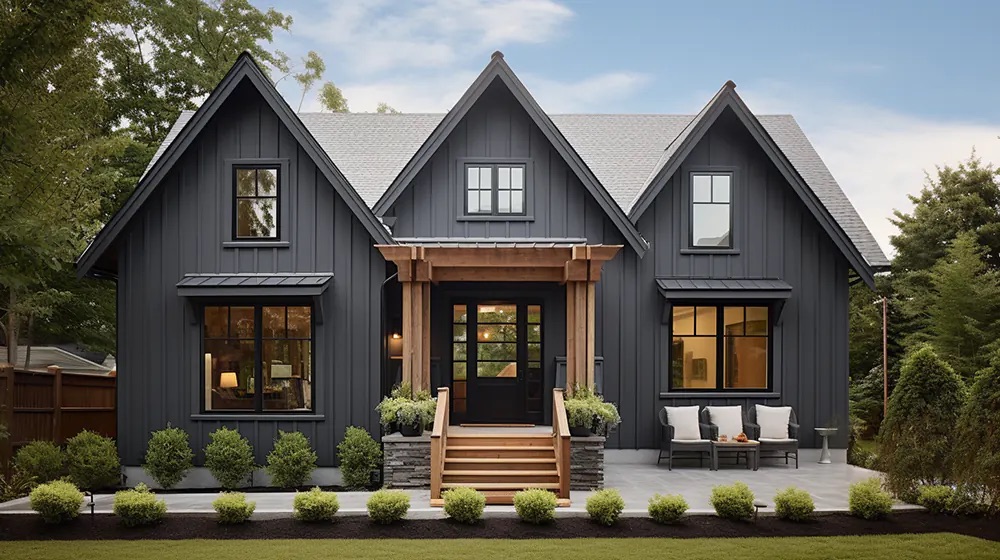
Board and batten siding offers a unique, rustic aesthetic appeal that can differentiate a building to add a hint of sophistication and character. With the vertical orientation of the boards and battens, it provides a visually pleasing contrast to most structures, which primarily features horizontal design elements.
Customizable Design
- Board and batten siding allows for a high degree of customization.
- There are various options for arranging and sizing the boards and battens, allowing opportunities to create unique designs.
- Additionally, most materials used for board and batten siding can be painted in any color, which allows for even more design flexibility.
Durability and Protection
One of the significant advantages of board and batten siding is its durability. When constructed with high-quality materials, it can withstand a variety of weather conditions, providing strong wind resistance and enhanced structural stability. Furthermore, the overlapping design offers excellent water resistance, reducing the risk of damage to the structure's interior.
Cons of Board and Batten Siding
High Installation Costs
Despite its many benefits, one of the drawbacks to board and batten siding is its high cost, particularly for high-quality materials like cedar. Installation can also be complex, potentially requiring professional installation – another cost to consider.
Ideal for Certain Architectural Styles Only
While board and batten siding can add character to a building, its unique design may not be suitable for all architectural styles. It is generally better suited for country-style homes or buildings aiming for a rustic aesthetic. The use of board and batten siding in more modern or urban settings may appear out of place.
Maintenance Issues
- Depending on the materials used, board and batten siding may require regular, ongoing maintenance to maintain its aesthetic appeal and structural integrity.
- Wooden board and batten siding, for example, may need regular treatments to prevent rot and damage from insects.
- Paint on board and batten siding may also peel or chip over time, requiring repainting or refinishing.
Environmental Impact
If you are considering wooden board and batten siding, it is essential to consider its environmental impact. Though wood is a renewable resource, the process of harvesting and transporting it can be harmful to the environment, particularly if the wood is not sourced sustainably.
Conclusion
In conclusion, the decision to use board and batten siding should involve considering these various pros and cons to make the most suitable choice for your building. While it offers a unique aesthetic appeal and considerable durability, board and batten siding also comes with potential high costs, maintenance issues, restricted design applications, and considerations about environmental sustainability.
Summary
The first conclusion that can be drawn about board and batten siding is its durability. This siding is designed to weather harsh climates and resist damage from elements like wind and rain. Plus, it offers added insulation keeping your house warm during winters and cool in the summer. The combination of boards and battens create an effective barrier against the elements.
Secondly, board and batten siding offers a unique aesthetic appeal. It has a classic and rustic look that can instantly add character to any home. This siding style stands out from the more commonly used siding options, making your home a standout in the neighborhood. It's an exceptional choice for those who for those seeking a distinctive and timeless look for their homes.
Finally, board and batten siding is versatile and customizable. Available in a variety of materials and colors, homeowners can choose the perfect fit for their property. Whether you are going for a traditional look with wood or a more modern look with vinyl, you're sure to find an option that fits your style. With board and batten siding, you can customize your home's exterior just how you like it.
About GVD Renovations & Remodeling
Welcome to GVD Renovations & Remodeling! We're the go-to project handlers for home transformations in Sacramento, CA, and surrounding areas. With our experienced crew, impeccable project management skills, and relentless drive for perfection, we're capable of delivering high-quality results while adhering to your timelines and budget. We're passionate about creating stunning, functional spaces that embody our clients' unique lifestyles and preferences. Driven by our commitment to exceptional customer satisfaction, we always go the extra mile to ensure your vision is brought to life right down to the smallest detail.
Tags: Board and Batten Siding,


